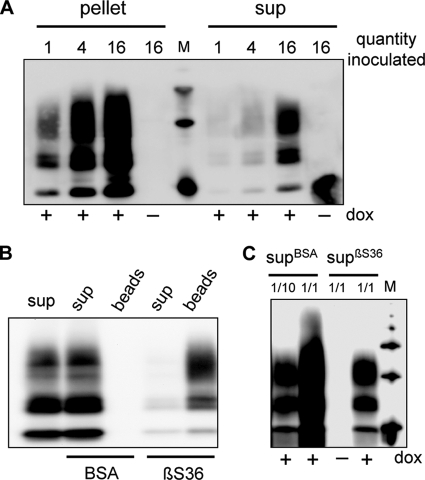FIGURE 2.
PrPres from the soluble fraction is infectious in the Rov cell-based assay. A, pellet and supernatant (sup) fractions were recovered after 100,000 × g centrifugation of PK-digested lysates from infected Rov cells. Equivalent portions (from 1 to 16, 1 corresponds to 175 μg of proteins in the original lysate) of each fraction were used to infect target Rov cultures. Three weeks later the cultures were solubilized and analyzed for the presence of PrPres. No PrPres was detected when inoculated Rov cultures did not express ovine PrP (dox−). B, PrPres was depleted from the supernatant fraction. PrPres remaining in the supernatant fraction (sup) after immunoprecipitation with βS36 mAb- or BSA-coupled magnetic beads was analyzed. Immunoprecipitated PrPres was also analyzed in parallel (beads). The anti-PrP mAb used to reveal the blot was coupled with peroxidase. C, Rov cells were infected with immunodepleted supernatants. Various amounts (from 1/10 to 1/1) of either βS36-depleted supernatants (supβS36) or control BSA-depleted supernatants (supBSA) were used to infect target Rov cells. Four weeks later, the cultures were solubilized and analyzed for the presence of PrPres. No PrPres was detected when inoculated Rov cultures did not express ovine PrP (dox−).

